Bringing the Great Outdoors Inside with Biophilic Interior Design
As our society becomes ever more digitized, many yearn to leave the built environment and return to nature. People increasingly want to connect with the natural world in a way that modern urban living has made almost virtually impossible. All that said, there’s a solution to this conundrum: biophilic interior design.
We’ll explore this design style’s origins, how it differs from similar design modes, its benefits, the most notable characteristics and how to make your home biophilic.
Going Back to Mother Nature
“Biophilic” is the adjective of the noun “biophilia,” which means a love of living things. This adoration for life and nature forms the basis of the motivation behind biophilic design. E.O. Wilson, a biologist and university professor, first introduced the concept almost four decades ago in his book entitled “Biophilia.” In it, he explains how human beings are instinctively drawn to the natural environment and try to mimic its processes.
Biophilic design aims to imitate nature in our architecture and infrastructure, making them an extension of nature. While this may sound a lot like green and/or sustainable design, biophilic design is very much its own unique approach to building and decorating.
Why? Green or eco-friendly design is first and foremost focused on creating living spaces that have minimal environmental impact. They’re energy-efficient, reduce water consumption, minimize waste and lower carbon emissions. Sustainable design is also green, but it takes people’s well-being into account, too.
By contrast, biophilic design is primarily centered on emulating nature. The idea is simply to create buildings that allow occupants to feel more connected to nature. It enables us to experience and interact with the natural elements much more closely. So, it’s not necessarily green or sustainable, but it can be!
Why Choose Biophilic?
The answer is simple: It has a host of varied benefits. The first one is psychological. Being in nature is relaxing because it’s incredibly peaceful for many people. This reduced stress and anxiety is beneficial in promoting good mental health.
It has advantageous physical effects, too. It’s widely believed that an indoor space that emulates nature is conducive to healing from injury and illness. This is why you’ll often find fake plants and murals of natural scenes in hospitals and hospices.
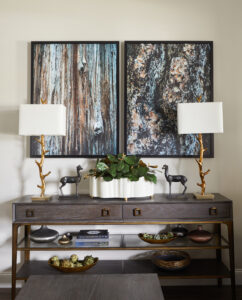
Biophilic design also enhances health, primarily because of improved air quality due to circulating fresh air and having live vegetation to “clean” it. If you opt for a biophilic design that’s also green and sustainable, you’ll also enjoy financial pay-off as a result of reduced energy use, meaning lower utility bills.
Facing the Elements of Biophilic Design
Let’s talk a bit about the most central biophilic design principles.
Natural lighting
We rely on electricity for almost everything, including lighting. Biophilic design greatly values capitalizing on natural light produced by the sun and, to an extent, the moon and stars.
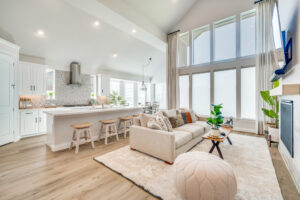
Plants and greenery
Biophilic interiors heavily feature plenty of flowers, potted plants, vines, creepers, succulents and any other flora imaginable. Intuitively, real, living ones are preferable.
Flowing water
We’re dependent on running water and plumbing. While biophilics don’t suggest manually retrieving buckets of water from a well, they do highly recommend water features that mirror naturally occurring bodies of water.
Sensory stimuli
The sights, sounds and smells are the first things you notice outdoors. So, including equipment, furniture and decor that imitate nature are crucial in biophilic design.
Organic shapes
Although one does find geometric forms that follow rigid mathematical principles in nature (think of an echeveria succulent or even honeycomb), most lack straight lines and angles. So, you’ll find curved, natural shapes without a discernible pattern in biophilic design.
Fresh air
Biophilic design prioritizes circulating air naturally, without the use of air conditioners. Greenery is often used to this end in biophilic design, as they convert the carbon dioxide our bodies produce and exhale into oxygen that we (and other animals) breathe in, purifying it in the process.
Earthy colors
Natural shades and hues are the order of the day in biophilic design. Think grays, browns, beiges, greens and blues. The vibrant jewel tones seen in flowers, birds, insects and reptiles aren’t off the cards but include them in moderation.
Varied scales
Not many geographic features are perfectly level or angled. Biophilic design plays around with height and dimension. Imagine unevenly curved mountains and sand dunes, for example.
Rich textures
Most (if not all) things in nature aren’t perfectly smooth before processing. Rather, you’ll find an abundance of different textures, from rough tree bark to fine sand and soft animal pelts. Biophilic design tries to include as many of these as possible.

Creating a Biophilic Interior
So, how do you make your home biophilic? We’ve listed some handy tips and tricks below.
Maximize natural light
If you’re at liberty to do construction on your abode, construct skylights, windows spanning the full length of walls and/or sliding doors to let in as much sunlight (and moonlight or possibly even starlight) as possible. Lots of windows and doors you can open will also help create fresh air.
Include tons of plants
You should fill your home with plenty of greenery, including potted plants, cacti or succulent gardens and even a living wall that consists of vines and other flora that can grow on vertical surfaces. You can plant grass and other flora in and around water features to make small gardens right inside your home, too. Flora assists with keeping the air clean, too.
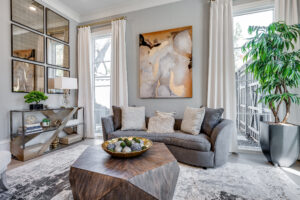
Invest in a water feature
If you can build on your home, create organic-looking bodies of water in your home, like little streams and ponds. Water like this is great for producing earthly sights, sounds and smells.
Develop an immersive sensory experience
You can install a surround-sound system to play bird and insect sounds. In addition to the scents your plants produce, you can also use a scent diffuser (but keep it out of sight) to produce earthy smells. Lemongrass, sandalwood and lavender are all good options.
Use a natural color palette
Your color scheme should mostly consist of neutrals and subtle cool and warm tones like sky blue, sage green, yellow ochre and burnt sienna. Think gray stone floors, light gray or beige walls, emerald green upholstery you get the idea. You may add in some pops of brighter colors in small decorations here and there, but use them sparingly.
Choose gentle lines
Some of your furniture will necessarily have sharp angles (like chairs), but opt for circular, oval or snaky shapes wherever possible. Round coffee, dining and side tables, sloping chaise longues and armchairs, squiggly mirrors and round lampshades are all good ideas.
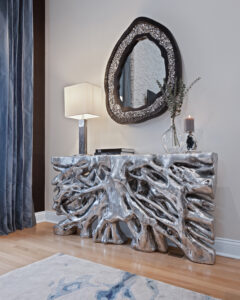
Utilize varied heights
Don’t be afraid to affix shelves and cabinets at different levels to prevent too much uniformity. Also, consider creating sunken or elevated floors if you’re allowed to carry out construction.
Select different textures
Have fun combining different feels. Smooth, cool stone floors can be accompanied by faux fur carpets, pillows and blankets. Perhaps you can include some reclaimed wood that’s not perfectly sanded, like driftwood furniture. Soft cotton upholstery juxtaposed with rougher canvas is a good idea, too.
Purchase natural materials
You may have noticed that most of the listed examples of decor and furniture describe materials. Choose those that are found in the wild: Cotton, silk, wood, natural stone and leather are all great to use. If you don’t want real animal hides in your home, fake versions are fine. Basically, steer clear of artificial polyesters and other manufactured fabrics.
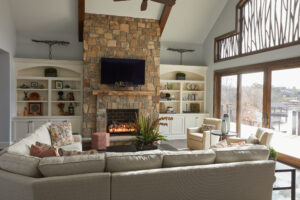
Biophilic interior design may come naturally (once again, no pun intended) to folks who are already nature lovers. But, if you’re just dipping your toe in these waters, you may find yourself needing some help remodeling your home in this style.
Decorating Den Interior’s decorating experts are here to help! Just contact us, and we’ll assign a personal designer who will meet with you to discuss your vision and take measurements, photographs and all the other details they need. Then, they’ll jump into creating the design plans.
Once you’ve given those the go-ahead, your decorating team will get to work turning your dreams into reality. Ready to go into the wild? Reach out to us today!









